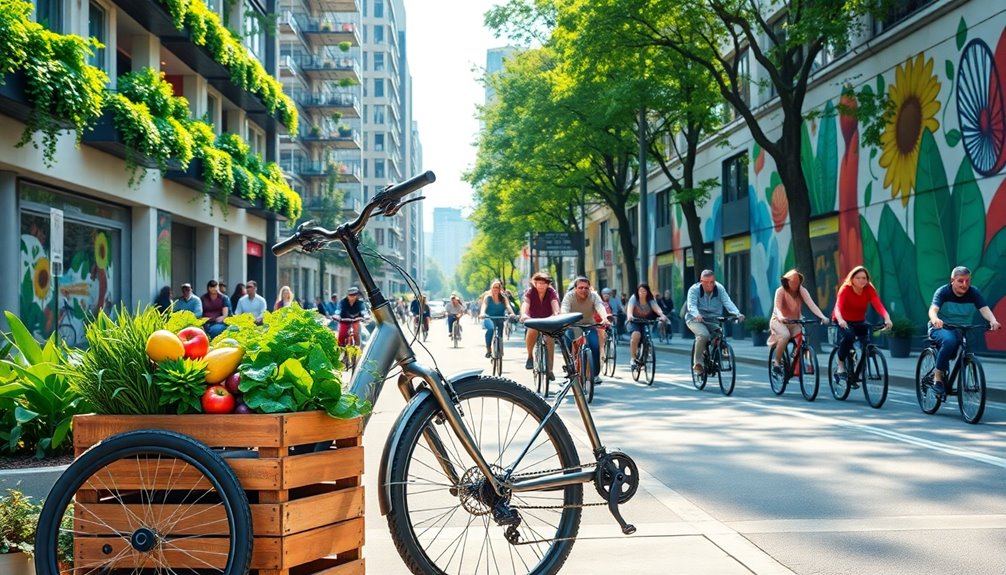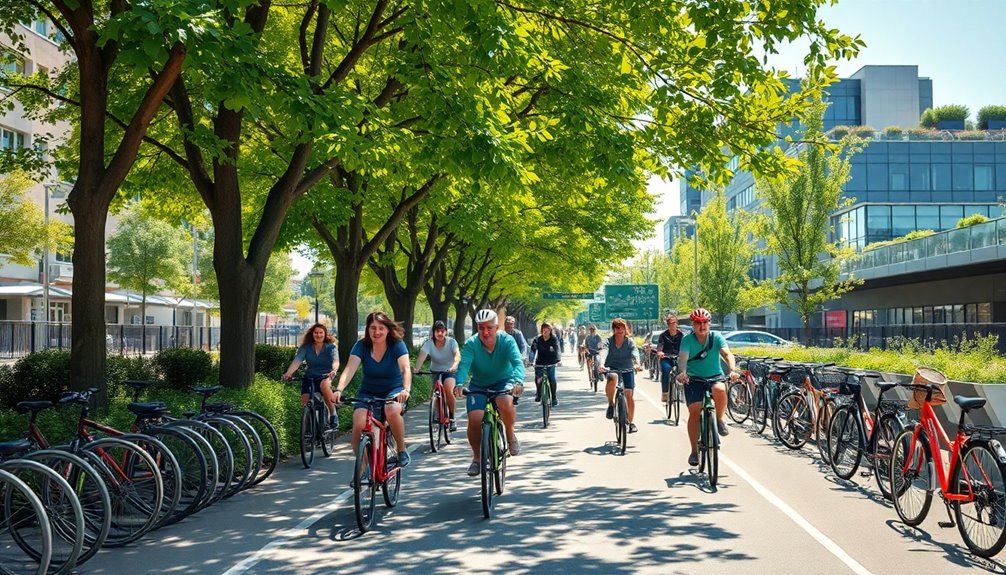Cycling's a fantastic way to embrace eco-living, cutting down carbon emissions and enhancing air quality. You'll not only improve your health by reducing heart disease risk and anxiety but also contribute to cleaner urban spaces. Investing in cycling infrastructure makes communities more bike-friendly, fostering a culture of sustainability. Plus, with innovations like e-bikes and smart technology on the rise, the journey and benefits of cycling just keep getting better. Discover how these elements work together for a brighter, greener future.
Key Takeaways
- Cycling significantly reduces carbon emissions, contributing to cleaner air and a sustainable urban environment.
- Regular cycling enhances physical health, lowering the risk of heart disease and promoting mental well-being.
- Investment in cycling infrastructure fosters community engagement and encourages more people to adopt biking as a primary mode of transport.
- Promoting eco-friendly transportation options like cycling cultivates a culture of sustainability within communities.
- Innovations in cycling technology, such as smart bikes and solar-powered lanes, enhance the overall cycling experience and environmental benefits.
The Environmental Benefits of Cycling

When you choose cycling over driving, you're not just making a healthier choice for yourself; you're also greatly reducing your carbon footprint.
Cycling emits only 21 grams of CO2 per kilometer, a stark contrast to cars that release around 271 grams. By embracing cycling, you contribute to a sustainable transportation system that substantially lowers carbon emissions and enhances air quality.
Cycling produces just 21 grams of CO2 per kilometer, while cars emit a staggering 271 grams, showcasing the environmental benefits of biking.
Plus, as more people cycle, urban congestion decreases, allowing for smoother city movement and improved accessibility for everyone.
Healthier populations from increased cycling can also lead to reduced healthcare costs, as active lifestyles are linked to fewer health issues.
Investing in cycling infrastructure supports these benefits, promoting a cleaner environment and encouraging even more individuals to ditch fossil fuels for two wheels. Additionally, integrating renewable energy sources into transportation systems can further enhance sustainability efforts.
Urban Mobility and the Role of E-Bikes

As cities grapple with increasing traffic and pollution, e-bikes emerge as a practical solution for urban mobility. They consume about 20 watts per mile, much less than cars, which use 300 to 600 watts. This energy efficiency makes e-bikes an excellent choice for getting around town.
By integrating e-bikes into public transport systems, you can enhance last-mile connectivity, making it easier to travel between stops and your final destination. Plus, e-bikes reduce traffic congestion and occupy less space, promoting better urban planning.
With zero tailpipe emissions, they considerably lower greenhouse gas emissions and contribute to cleaner air. Improved cycling infrastructure can lead to millions more bike trips, further enhancing urban mobility and fostering sustainable transportation.
Health Advantages of Active Transportation

Cycling offers numerous health benefits that can transform your daily routine into a path toward better well-being.
By choosing cycling over public transportation, you can considerably enhance your cardiovascular health—just 30 minutes a day can cut your heart disease risk by 50%. This active transportation method boosts your overall physical activity levels by 20%, helping combat obesity.
You'll also enjoy improved mental health, as regular cyclists report lower anxiety and depression. Plus, cycling exposes you to fresh air, which can enhance lung health and decrease the risk of respiratory issues linked to air pollution. Additionally, studies suggest that engaging in regular physical activity, like cycling, can improve cognitive functions and emotional resilience.
Ultimately, embracing cycling not only benefits you but can also reduce healthcare costs, creating a healthier community for everyone.
Investment in Cycling Infrastructure

When you think about investing in cycling infrastructure, consider how funding for cycle paths can transform your community.
It's essential to push for government policy changes that prioritize cycling alongside other transportation options.
Engaging your local community in these initiatives not only promotes cycling but also fosters a sense of ownership and responsibility for safer streets.
Funding for Cycle Paths
Investing just £10 per person per year can greatly enhance cycling infrastructure, making communities more bike-friendly. This funding for cycle paths is essential, especially as current government spending often prioritizes electric vehicle infrastructure over safe cycling facilities.
By allocating funds to develop protected lanes and secure parking, you can help create an environment that encourages more bike trips. Enhanced cycling infrastructure could result in a billion more bike journeys, alleviating congestion and boosting local economies.
More importantly, this shift supports public health by promoting active mobility and transforming public spaces. By prioritizing investments in cycling, you're not just improving transportation options; you're contributing to a healthier, more sustainable community for everyone.
Government Policy Changes
Funding for cycle paths lays the groundwork for necessary government policy changes that prioritize cycling infrastructure.
When governments invest just £10 per person annually, you could see a dramatic shift in urban transport dynamics, leading to more cycling and reduced congestion.
Research shows that safe cycling infrastructure, such as protected lanes and secure parking, can spur a billion additional bike trips, enhancing not just transport systems but also overall quality of life.
Policy shifts that favor cycling over car-centric designs are essential; they promote healthier, more active communities.
Community Engagement Initiatives
As communities recognize the importance of cycling, engaging residents in discussions about infrastructure becomes essential.
Investing around £10 per person per year can markedly enhance cycling routes and boost cycling rates. Safe cycling infrastructure not only promotes public health by encouraging active transportation but also reduces traffic fatalities, showcasing its positive environmental impact.
Cities like Amsterdam and Copenhagen illustrate how prioritizing cycling networks leads to increased community engagement and higher property values.
Unfortunately, current government spending often leans toward electric vehicle infrastructure, sidelining vital cycling facilities.
Promoting a Culture of Sustainability

To promote a culture of sustainability, you can start by embracing eco-friendly transportation like cycling.
Building community awareness initiatives helps everyone understand the benefits of biking, while encouraging active lifestyle choices fosters healthier habits. Additionally, promoting energy-efficient systems can further enhance the sustainability of urban environments.
Together, these efforts create a more sustainable and vibrant urban environment for all.
Embracing Eco-Friendly Transportation
How can we foster a culture of sustainability in our daily lives? Embracing eco-friendly transportation through cycling is a powerful step.
Riding on two wheels emits only 21g of CO2 per kilometer, drastically reducing emissions compared to cars, which release 271g. E-bikes further enhance this by consuming just 20 watts per mile, making them incredibly energy-efficient.
By increasing cycling, not only do we contribute to a cleaner environment, but we also promote healthier lifestyles, reducing healthcare costs.
Investing in cycling infrastructure, even a small amount like £10 per person yearly, can lead to a billion more bike trips.
Let's integrate e-bikes into our transport systems to ease congestion and support sustainable urban living.
Moreover, the shift towards renewable energy sources can further enhance the sustainability of cycling initiatives.
Choose two wheels today!
Building Community Awareness Initiatives
What if your community embraced cycling as a way to enhance both sustainability and public health? By building community awareness initiatives, you can promote a culture of cycling that reduces traffic congestion and encourages safer, healthier modes of transport.
Consider these key strategies:
- Educational Programs: Provide hands-on experiences for residents to understand the challenges cyclists face, highlighting the need for bike lanes.
- Advocacy Efforts: Push for transportation planning that prioritizes non-motorized users, creating equitable environments for walkers and bikers.
- Community Engagement: Host events and discussions to showcase the benefits of cycling, fostering participation and commitment to sustainable practices.
Together, these initiatives can transform your community into a vibrant, cycling-friendly environment that supports everyone's well-being.
Encouraging Active Lifestyle Choices
Building on the momentum of community awareness initiatives, encouraging active lifestyle choices can further promote a culture of sustainability.
By embracing cycling as a primary mobility option, you can greatly reduce carbon emissions—bicycles emit only 21g of CO2 per kilometer compared to 271g for cars. Regular cycling not only enhances your physical health but also contributes to lower healthcare costs associated with sedentary lifestyles.
Investing in cycling infrastructure fosters this shift; for just £10 per person per year, you can see increased cycling rates and economic activity in your community.
Plus, integrating electric vehicles like e-bikes makes longer commutes easier, enticing more people cycling. Together, these choices create a healthier, more sustainable future for everyone.
Future Innovations in Cycling Technology

As technology continues to evolve, the future of cycling looks promising with innovative advancements set to enhance both performance and sustainability.
You'll soon see a shift towards bicycles that serve as a reliable mode of transport, reducing range anxiety for commuters.
Key innovations include:
- Lightweight, durable materials that improve efficiency and cut energy consumption.
- Smart bicycles with IoT technology, giving you real-time data on speed, distance, and battery life.
- Advanced battery systems, like solid-state batteries, that minimize charging times and expand e-bike ranges.
Additionally, features like regenerative braking and automatic lights will boost safety and energy efficiency. Furthermore, integrating solar-powered bike lanes into urban infrastructure will further enhance the sustainability of cycling.
With these innovations, cycling will become an even more attractive option for eco-conscious travelers.
Frequently Asked Questions
Is It True That Riding a Bicycle Is Not Sustainable?
It's not true that riding a bicycle isn't sustainable. In fact, cycling emits far less CO2 than cars, making it a much cleaner transportation option.
When you choose to bike, you help reduce greenhouse gas emissions, improve air quality, and promote better public health through physical activity.
Plus, bikes take up less space, easing traffic congestion and optimizing urban areas.
How Sustainable Are Ebikes?
Think of e-bikes as the gentle breeze that whispers sustainability in your ear.
They're much more energy-efficient than cars, using around 20 watts per mile, while cars guzzle 300 to 600 watts. E-bikes also produce no tailpipe emissions, helping to clear the air.
However, it's crucial to reflect on the environmental impact of lithium battery production.
How Does Cycling Promote Sustainability?
Cycling promotes sustainability by greatly reducing carbon emissions compared to cars.
When you ride a bike, you're contributing to cleaner air and less traffic congestion, making urban areas more livable. You also help diminish reliance on fossil fuels, fostering a healthier planet.
Plus, cycling encourages a more active lifestyle, which can lead to lower healthcare costs.
How Much CO2 Does Cycling Really Save?
Did you know that cycling emits just 21 grams of CO2 per kilometer, while cars produce a staggering 271 grams? That's a huge difference!
By choosing to cycle instead of drive, you can considerably lower your carbon footprint. If more people embraced cycling, we could see millions of tons of CO2 emissions saved each year.
Not only does this contribute to cleaner air, but it also promotes healthier lifestyles for everyone.
Conclusion
As you hop on your bike, you're not just getting from point A to B—you're contributing to a healthier planet and your own well-being. Every pedal stroke reduces your carbon footprint and promotes a vibrant, sustainable community. With the rise of e-bikes and innovative cycling tech, the future of urban mobility looks bright. So, let's embrace this eco-friendly lifestyle together, making every ride an opportunity to enjoy nature and connect with those who share your passion for sustainability!









